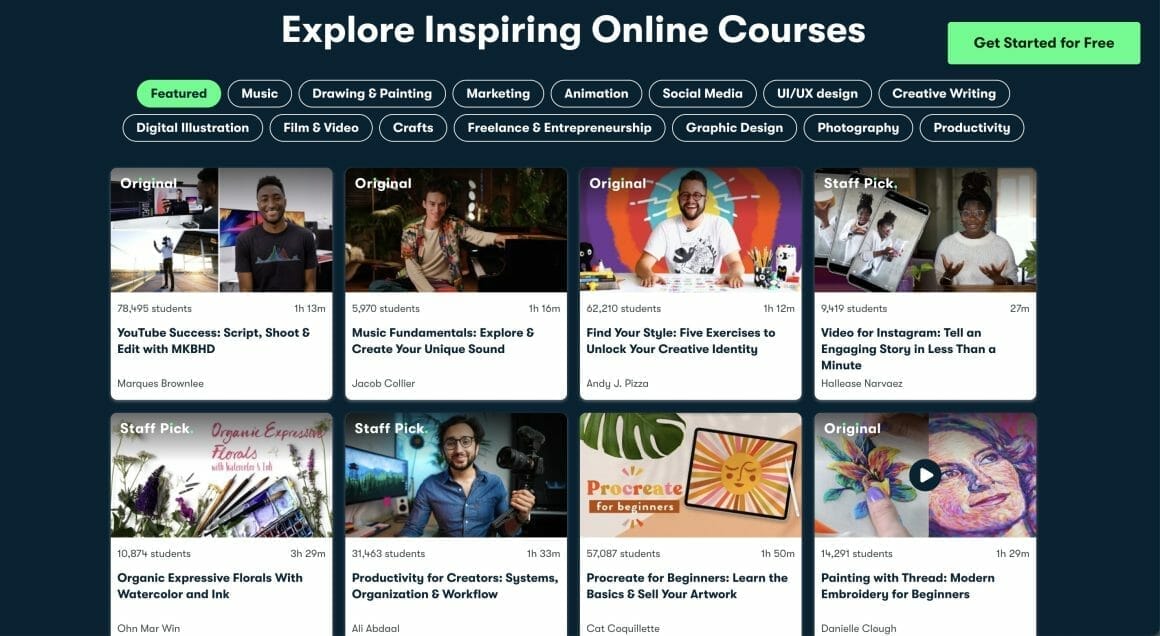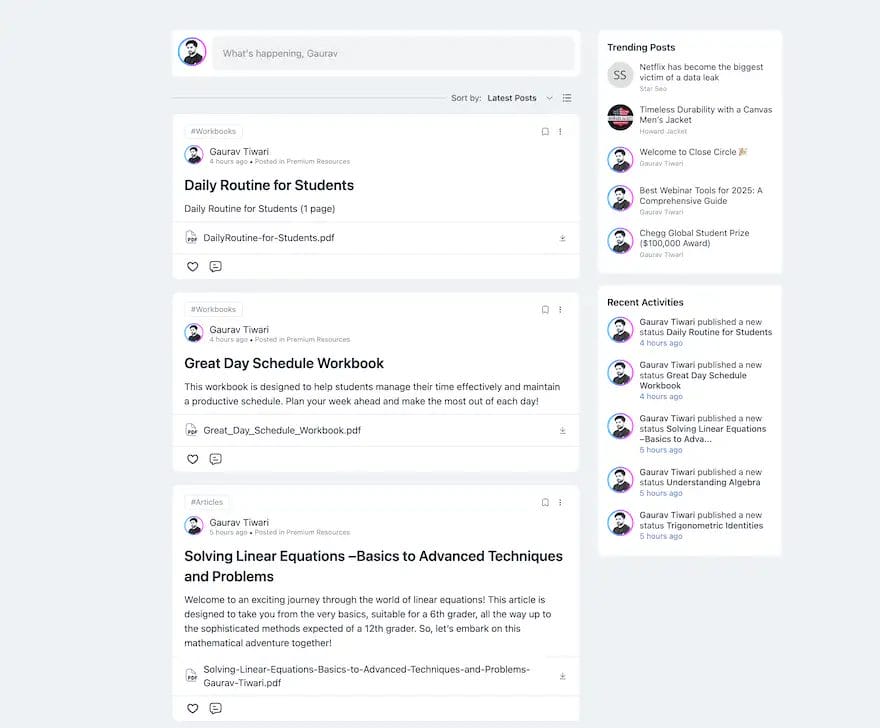How to Teach Online? (The Ultimate Guide)
Do you want to teach online and have no idea where to start? If that’s so, this is the best place to be. In this article, I will help you understand the nuances of teaching online and how you can make the most out of your hard work the smart way.
Online teaching is a promising and lucrative sector that can help you grow your online presence. Many coaches choose to augment their one-on-one services by providing online courses, and several entrepreneurs have established profitable businesses exclusively using online courses.
By teaching online, you can:
- Channel your inner solopreneur
- Choose your working hours as per your convenience
- Build authority in your field
- Create a brand true to your values
- Have a solid business foundation
- Showcase your talents and expertise to the world
- Turn leads into customers
- Work fully remotely
It doesn’t matter whether you’re an entrepreneur wanting to start a blooming online business or an experienced professional hoping to diversify your income; online teaching could be just the way to go.
Let’s now see the actual process of doing just that.
Table of Contents
How to Start Teaching Online?
Currently, there are three main ways to start online teaching:
- Use a Learning Management System (LMS) plugin to offer courses through your own WordPress website.
- Use an online teaching platform.
- Use online course marketplaces.
If you require a solution that gives you complete control over every aspect of your business, then I advise you to offer courses on your own WordPress website. However, online teaching platforms and course marketplaces have their own advantages as well.
Let’s begin by discussing how to create courses on your own platform.
Using WordPress + LMS Plugin
Summary: Get a domain, hosting with WordPress installed, install an LMS plugin, and you are good to go. Complete guide is here →

WordPress is the free and flexible Content Management System (CMS) of choice for most entrepreneurs today. With the right Learning Management System (LMS) plugin, you can also use it as a teaching platform to deliver access-restricted learning resources and lessons to students.
See this detailed guide on how to start an online teaching website with WordPress.
I should mention that using WordPress to build and sell online courses on your own website is the only solution where you actually have absolute control over your teaching career.
All you need is to pick a hosting:
And then, choose a WordPress theme that fits your needs:
| Theme | Description | Original Price | Discount | Validity | Get Deal |
|---|---|---|---|---|---|
| Kadence | Build fast & beautiful websites with Kadence. Modern features & customization for all. | $149 | 40% off + GTSAVE10 (extra 10%) | Nov 15 - Dec 2 | Get Deal on Kadence |
| Astra | Lightweight, fast theme with beautiful templates and page builder support. | $59-$699 | Up to 50% off | Live until Dec 5, 2024 | Get Deal on Astra |
| GeneratePress One | Premium theme bundle with GenerateBlocks and GenerateCloud access. | $149 | $30 off | Live until Dec 5, 2024 | Get GeneratePress One |
| Themeforest | Marketplace for premium themes including Total, BeTheme, and more. | $13 - $199 | 50% off select items | Live until Dec 5, 2024 | Get Themeforest Themes |
| WPZoom | Premium themes for education, news, magazines, and more. | $79 per theme | 30%-70% off | Live until Dec 5, 2024 | Visit WPZoom |
| TemplateMonster | Wide selection of themes & plugins across all web categories. | Variable | Up to 50% off | Nov 15 - Dec 2 | Get Deal on TemplateMonster |
| MonsterONE | Access to an extensive asset library for WordPress themes & design tools. | $529 (lifetime) | Up to 40% off | Nov 15 - Dec 2 | Get Deal on MonsterONE |
| Neve | Fast, mobile-first theme with customizable headers & footers. | Variable | Up to 65% off | Nov 15 - Dec 2 | Get Deal on Neve |
| Avada | Popular drag-and-drop theme for feature-rich websites. | Variable | 34% off | Nov 15 - Dec 2 | Get Deal on Avada |
| Divi | Customizable theme with powerful design options and pre-made layouts. | Variable | 25% extra off | Nov 15 - Dec 2 | Get Deal on Divi |
| Blocksy | Lightweight, customizable theme optimized for performance. | Variable | 40% off annual, 30% off lifetime | Nov 15 - Dec 2 | Get Deal on Blocksy |
| Total | Multipurpose theme with drag-and-drop functionality and flexible layouts. | Variable | 50% off | Nov 15 - Dec 2 | Get Deal on Total |
Once you are done with these, all you need now is install and setup an LMS plugin. Here are the LMS plugins that I recommend:
- LearnDash (Premium)
- LearnPress
- Tutor LMS
- Sensei LMS
- MemberPress Courses (Premium)
- LifterLMS
The full guide to setting up hosting, theme and LMS can be read here.
The other two methods are hosted Software as a Service solution and you might not be in complete control of everything.
With WordPress, you’ll get to control:
- Who your courses are marketed to!
- How your courses are marketed!
- Your courses’ prices
- Course evaluation methods
- Drip scheduling course material
- Reporting and analytics
- Teaching on an individual basis or in cohorts
- The contact information for your students
- When to run discounts and sales
- Your course material’s format (audio, video, text, etc.)
- Your course website’s visual design
Use an online teaching platform

See: Best Online Teaching Platforms for Educators to Create & Sell Online Courses
Online teaching and tutoring platforms are growing larger by the day. They’ve given teachers of all experience levels an opportunity to make money online. Some of the most popular domains include secondary subject tutoring, language learning, and further education. These platforms also enable you to create an online teaching space, provide study materials, and offer regular feedback to improve your performance as a teacher.
If you’re seeking a straightforward way to become an online teacher without the trouble of setting up any tech, then joining a teaching platform could be the ideal option for you. To join, you must prove that you have strong teaching abilities and knowledge in your field. Also, you’ll likely have to do a live or recorded trial lesson to get approved.
Below are some of the most reputable companies on the market:
| Platform | Monthly Cost | Annual Cost | Trial | Sign up link |
|---|---|---|---|---|
| Thinkific | Free to $499 | Free to $4788 | Free Tier Forever | Create an Account |
| Teachable | Free to $299 | Free to $2988 | Unlimited with Free Plan | Create an Account |
| LearnWorlds | $29-$299 | $288-$2988 | Up to 14 days | Create an Account |
| Coursera | $399 per year | $399 per year | - | Create an Account |
| Graphy | $59-$349 | $648-$3840 | Available | Create an Account |
| Udemy | Individuals: Free on Commission Base Business: $360 per user per year | Individuals: Free on Commission Base Business: $360 per user per year Higher plans available for enterprises and corporations | Unlimited with Free Plan | Create an Account |
| Kajabi | $149-$399 | $1428-$3828 | Up to 14 days | Create an Account |
| Skillshare | Free to $159 per user per year to custom plans | Free to $159 per user per year to custom plans | Unlimited | Create an Account |
| Zenler | $67-$197 | $647-$1447 | Available | Create an Account |
| Xperiencify | $49-$149 and custom plans | $504-$1404 | Available | Create an Account |
| LinkedIn Learning | Free (if you are selected) | Free (if you are selected) | Unlimited | Create an Account |
| Uscreen | $99-$199 + $0.50 per subscriber | $948-$1908 + $0.50 per subscriber | - | Create an Account |
| Podia | $39-$199 | $390-$1990 | Up to 14 days | Create an Account |
| Upwisy | Free to $99 | Free to $948 | Up to 20 learners | Create an Account |
| Simplero | $70.80-$178.80 | $708-$1788 | Up to 14 days | Create an Account |
| Mighty Networks | $39-$119 | $390-$1190 | Up to 14 days | Create an Account |
| WizIQ | $25 to customized plans | $300 to customized plans | Available | Create an Account |
| Pathwright | $99-$499 | $1068-$5388 | Available | Create an Account |
| Gumroad | Free + Commission based | Free + Commission based | Unlimited | Create an Account |
| Moodle | Free | Free | Free | Create an Account |
Although teaching platforms take care of the technical aspects of setting up a course, they have their disadvantages as well. For example, you will have limited control over the pricing and content of your services, potentially hindering your earnings and teaching style. Also, these platforms take a commission from your fees and significantly reduce your income.
Thus, I advise you to carefully consider these pros and cons before deciding to join a teaching platform.
Teaching on online course marketplaces

Let’s say you don’t want to work with an online teaching platform, either. In that case, you can choose to build and sell your courses through online course marketplaces such as Udemy, Udacity, and SkillShare.
Since these places offer a built-in audience, you needn’t build fancy marketing funnels to attract students.
However, although these course marketplaces let you easily build and launch online courses, they could cause some significant problems for your online business as well.
For example, the marketplace gives you limited control over your course pricing. They can discount your courses as they want and always take a significant portion of your revenue for their help.
In the marketplace, your courses must compete among hordes of competitors in your niche — all battling it out for customers with race-to-the-bottom pricing. Also, you won’t have access to your student email list, making it almost impossible to create a lasting and recurring revenue relationship with your course customers.
Tips on how to teach online
Now that you’re acquainted with the basics of online teaching, you can follow the guidelines below to prepare for success effectively.
1. Plan your classes well
In a virtual classroom, class time is usually short, and students hold out hopes to learn as much as they can in that given time period. Therefore, it is crucial to plan your lessons well in advance so you can make the most of that limited time.
2. Prepare and master the relevant technology
Before you can confidently teach students online, you must prepare and master the technology involved in the process. Moreover, being tech-savvy in general will help you be more successful as an online teacher. Below are some things you should be able to do:
- Discover platform tricks
- Identify common technological issues
- Know how to get tech support
- Understand if there’s mobile access or only desktop/laptop access
3. Put together a reliable working station
Theoretically, you might be able to teach from anywhere. Nevertheless, you should always try to set up a working environment that feels comfortable and familiar to you and your students. It will make the entire online teaching experience much smoother. For that, you should:
- Have the required equipment
- Have a background that captivates students
- Ensure that your internet connection is strong enough
- Try to soundproof your work environment as much as possible
- Eliminate distractions
4. Initiate discussions
It’s challenging to learn how to teach an online course. Therefore, you must start discussions with your students promptly so they can get comfortable and acquainted with you. Many students tend to feel nervous when the class beings; by asking some light questions, you will make them feel more comfortable.
5. Remember to communicate regularly
Regardless of the setting you’re teaching in, you need to communicate regularly with your students. Remember to always greet them at the beginning and end of each class. You should also communicate your expectations of the students throughout the lesson and remind them of the pending tasks and assignments.
6. Motivate your students
Naturally, some students will be eager to be in your classroom, while others will be distracted by something or the other. You can usually get them to be more interactive by finding ways to motivate them (and by keeping in mind their age and interests). You can do so using games, a points/reward system, or by promising time to talk about a topic of their choice after finishing the lesson.
7. Design your course content thoughtfully
When adapting a curriculum for online teaching, be as mindful as you can about designing the courses and organizing the content within them. Ensure that your content appeals to all learning styles and explain the material, expectations, and objectives as clearly as possible. This rule also applies to general things such as due dates on assignments.
8. Make your class’ atmosphere fun and welcoming
If you are teaching synchronously, try your best to make the class atmosphere as inviting as you can by:
- Eliminating distractions
- Looking prepared and ready to teach
- Making students comfortable
- Providing relevant examples
- Using gestures and facial expressions when appropriate
- Using media and interactive tools
- Using visual aids and props
9. Ensure that the lessons are age and level appropriate
Even if you have an advanced student, you must make sure that lessons are age appropriate. For example, if you teach English online and there’s a five-year-old in your class who already speaks English well, you shouldn’t be discussing 8th-grade-level science topics with them, even if they might be comfortable with the vocabulary.
10. Prepare homework and reading materials in advance
Students must work to accompany and supplement what they learn in an online lesson, just as they would when attending a physical class. Therefore, you should prepare homework and extra reading materials before starting the class.
11. Ask for help and feedback
Consistently asking for help and feedback is one of the best ways of preparing to teach online, as well as one of the basics of teaching in general. Find a friendly way to ask your students for their opinions regarding your classes and the scope for improvement. You can also get in touch with other online teachers, mentors, or the company for help when required.
Conclusion
Teaching online can be a great way to make money online, whether as a full-time job or as a side source of income. In this article, I’ve discussed the different routes online teaching can take you down and explained the benefits and pitfalls you’ll face along the way for each of them.
Before a student attends your first lesson, you must decide which approach to teaching online suits you best. Ascertain whether you prefer the complete control of offering courses on your WordPress website, the convenience of a teaching platform, or the wide reach of an online course marketplace.
With that in mind, I hope you embark on a rewarding and successful journey of teaching online.

